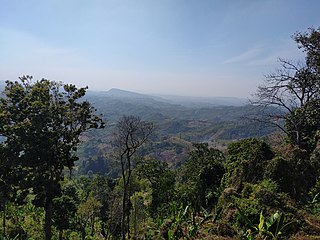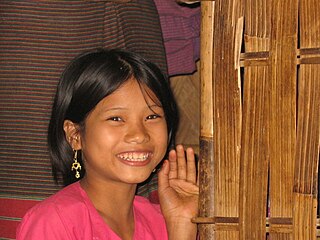Related Research Articles

The Chittagong Hill Tracts, often shortened to simply the Hill Tracts and abbreviated to CHT, are group of districts within the Chittagong Division in southeastern Bangladesh, bordering India and Myanmar (Burma). Covering 13,295 square kilometres (5,133 sq mi), they formed a single district until 1984, when they were divided into three districts: Khagrachari District, Rangamati Hill District, and Bandarban District.

Rangamati Hill District (Bengali: রাঙামাটি পার্বত্য জেলা; is a district in south-eastern Bangladesh. It is a part of the Chattogram Division, and the town of Rangamati serves as the headquarters of the district. By area, Rangamati is the largest district of the country.

Bandarban is a district in South-Eastern Bangladesh, and a part of the Chittagong Division. It is one of the three hill districts of Bangladesh and a part of the Chittagong Hill Tracts, the others being Rangamati District and Khagrachhari District. Bandarban district (4,479 km2) is not only the most remote district of the country, but also the least populous. There is an army contingent at Bandarban Cantonment.

The national language and official language of Bangladesh is Bangla according to the third article of the Constitution of Bangladesh. The second most spoken language in Bangladesh is claimed to be Burmese which is spoken by the Marma tribe in Chittagong Hill districts as the districts border Myanmar; it is also spoken by the Rohingya people. Almost 99% of Bangladeshis speak Bengali as their first language. Bengali Language Implementation Act, 1987 made it mandatory to use Bengali in all government affairs except in the cases of foreign relations. According to a 2022 census, Bengali is predominantly spoken by 99% of the country's population and it also serves as the national language of the nation. The indigenous people of northern and southeastern Bangladesh speak a variety of native languages. Bangladesh has 44 indigenous languages according to Professor Shameem Reza.

Zo is a Northern Kuki-Chin-Mizo language originating in western Burma and spoken also in Mizoram and Manipur in northeastern India.
Thadou or Thado Chin is a Sino-Tibetan language of the Northern Kuki-Chin-Mizo sub-branch. It is spoken mainly by the Thadou people and also the other Zo people/Kuki people tribes as their second language, as well as first in Northeast India. The speakers of this language use Meitei language as their second language (L2) according to the Ethnologue.
The Kuki-Chin languages are a branch of 50 or so Sino-Tibetan languages spoken in northeastern India, western Myanmar and southeastern Bangladesh. Most speakers of these languages are known as Mizo in Mizoram and Manipur. Also, as Kukī in Assamese and Bengali and as Chin in Burmese; some also identify as Zomi. Mizo is the most widely spoken of the Kuki-Chin languages. The Kuki-Chin language has official status in both Chin State and Mizoram as Chin and Mizo respectively.

The Bom, or Bawm, are an ethnic community inhabiting the Chittagong Hill Tracts of Bangladesh. The Bawm are one of smallest ethnic groups in Bangladesh. In 2004, around 10,000 Bawm inhabited India, with the population in all countries totalling around 24,500. In 2011, 12,000 Bawms inhabited the Chittagong Hills of Bangladesh, and 2,500 Bawm inhabited Myanmar. They speak the Sino-Tibetan Bawm language.

The Khumis, are a community inhabiting in the Chittagong Hill Tracts of Bangladesh. The Khumis are one of smallest ethnic groups in Bangladesh with a population of only 1214 according to the 1991 census, though there are another 120,000 across the border in Burma.
Kheyang is the exonym of the Hyow. There Kheyang or the Hyow (খিয়াং), are a group of indigenous people inhabiting in the Chittagong Hill Tracts of Bangladesh and the Rakhine State of Myanmar. The word Kheyang originated in khlɔng (see VanBik, 2009: 3–4), which means personin the language. The endonym Hyow means Chin. The Khyang are one of the smallest ethnic groups in Bangladesh with a population of only 2,345 according to the 1991 census. At present, the approximate number of the Khyang in Bangladesh is 4500. They live in Kaptai and Chandraghona in Rangamati Hill District and in Bandarban Sadar, Thanchi and Rowangcchari upazila in Bandarban District. . In Myanmar, they live in the Myebon, Minbya and Ann townships of the Rakhine State.
The Pankhos, are a community inhabiting the Chittagong Hill Tracts of Bangladesh and also in India with a population of only 3,227 in Bangladesh according to the 1991 census. In the 1981 census they were 2440 in number. In Bangladesh, the Pankhos live in Barkal in Rangamati Hill District close to Mizoram.
The Zo people/Kuki people are an ethnic group which inhabit areas of India, Myanmar and the Chittagong hill tracts of Bangladesh. The word Zohnatlâk/Zo is used to describe an ethnic group, which is also known as the Chin, the Mizo, the Kuki, or a number of other names based on geographic distribution, that speaks the Kuki-Chin languages. They are from same origin which is known as Sinlung. They spread throughout the northeastern states of India, northwestern Myanmar and the Chittagong Hill Tracts of Bangladesh. In northeastern India, they are present in Tripura, Nagaland, Mizoram, Manipur, Meghalaya and Assam.

Mru, also known as Mrung (Murung), is a Sino-Tibetan language of Bangladesh and Myanmar. It is spoken by a community of Mrus (Mros) inhabiting the Chittagong Hill Tracts of Bangladesh with a population of 22,000 according to the 1991 census, and in Rakhine State, Myanmar. The Mrus are the second-largest tribal group in Bandarban District of the Chittagong Hill Tracts. A small group of Mros also live in Rangamati Hill District.

Bangladeshis are the citizens of Bangladesh, a South Asian country centered on the transnational historical region of Bengal along the eponymous bay.
Thadou people are an indigenous tribe of Kuki people inhabiting Northeast India, Burma, Bangladesh, Israel.
Shö is a Kuki-Chin language dialect cluster of Burma and Bangladesh. There are perhaps three distinct dialects, Asho (Khyang), Chinbon, and Shendu.
Pangkhua (Pangkhu), or Paang, is a Kuki-Chin language primarily spoken in Bangladesh. Most speakers of Pangkhu are bilingual in Bengali, and most education in Pangkhu is conducted in that language.
Rengmitca is a critically endangered Kuki-Chin language of Bangladesh. It is distinct but closely related to the nearby languages Khumi and Mro. There are fewer than 30 speakers left as of 2014. Only 5 are completely fluent, all over the age of 60. But as of 2021 there are only 6 speaker of this language are left, most of whom are over the age of 60.
Kuki-Chin National Front, also known as Bom Party or Bawm Party, is an ethnic separatist organization in Bangladesh based in the Chittagong Hill Tracts. They are fighting for a separate autonomous state for Bawm people within Bangladesh.
References
- ↑ Bawm at Ethnologue (18th ed., 2015) (subscription required)
- ↑ The Sino-Tibetan Languages Graham Thurgood and Randy J. LaPolla
- ↑ Loncheu, Nathan (2013). Dena, Lal, ed. Bawmzos: A Study Of The Chin-Kuki-Zo Tribes Of Chittagong. Akansha Publishing House. ISBN 9788183703468. Retrieved 17 March 2013
- ↑ Kim, Roy & Sangma. 2011. The Kuki-Chin Communities of Bangladesh: A sociolinguistic survey. SIL International.
- ↑ Kim, Roy & Sangma. 2011. The Kuki-Chin Communities of Bangladesh: A sociolinguistic survey. SIL International.
- ↑ The Invention of the ‘Jummas': State Formation and Ethnicity in Southeastern Bangladesh, WILLEM VAN SCHENDEL
- ↑ Bawm at Ethnologue (17th ed., 2013)
